Taxonomy: Class: Mammalia; Order: Carnivora; Family: Felidae
Description
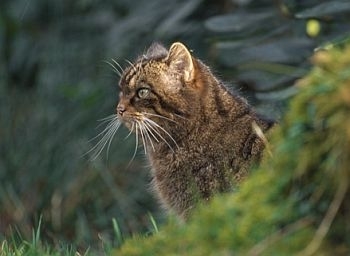
Wildcat © Laurie Campbell
The wildcat is Britain's only remaining native cat species. It is similar to a domestic tabby but larger, stockier and with a black-banded bushy tail. It is restricted to Scotland, where it inhabits the forested margins of moorland. It is under severe threat from hybridisation with feral cats and disease. The animal was routinely culled to reduce predation on game, but it was protected in 1988 under the Wildlife & Countryside Act. The wildcat has been recorded by the NGC only between 1971 and 1987.
Further information:
Mammal Society website wildcat page.
Conservation status and legislation
Status:
UK: Native. Priority species under the UK Biodoversity Action Plan
World: Least Concern (IUCN Red List)
Legislation:
Distribution and abundance
In the UK, the wildcat is restricted to central and northern Scotland, and is absent from the Scottish islands. Reports of wildcats further south probably refer to feral cats, although unofficial releases cannot be ruled out.
Estimates of wildcat abundance (numbers of individuals in the spring) across the UK, from Harris et al. (1995):
Recent trends from the National Gamebag Census
United Kingdom
Index of bag density from 1971 to 1987 (see statistical methods and interpretational considerations).
Error bars represent 95% confidence intervals.
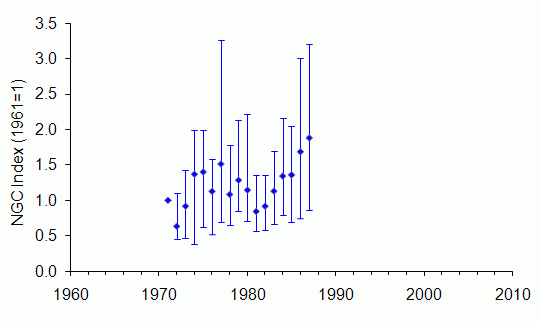
Data were available only for the period 1971-1987, during which there was no significant trend in the bag index. A total of 274 wildcats were recorded by the NGC from 40 shooting estates in central, eastern and north-eastern Scotland in 1984-1985 (Easterbee et al. 1991).
Change in wildcat bags over time, with 95% confidence limits (see statistical methods):
| Country |
Sites |
Start
year |
End
year |
Change (%)
1961-2009 |
Change (%)
1984-2009 |
Change (%)
1995-2009 |
| United Kingdom |
51 |
1971 |
1987 |
125
-17 to 290 |
no data |
no data |
* significant at P < 0.05
England
There are too few bag records of wildcat to produce an index graph. 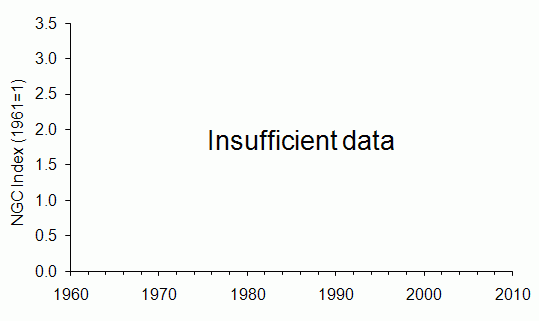
There are too few bag records of wildcat to evaluate rates of change over time
| Country |
Sites |
Start
year |
End
year |
Change (%)
1961-2009 |
Change (%)
1984-2009 |
Change (%)
1995-2009 |
| England |
Too few sites |
Scotland
Index of bag density from 1971 to 1987 (see statistical methods and interpretational considerations).
Error bars represent 95% confidence intervals.
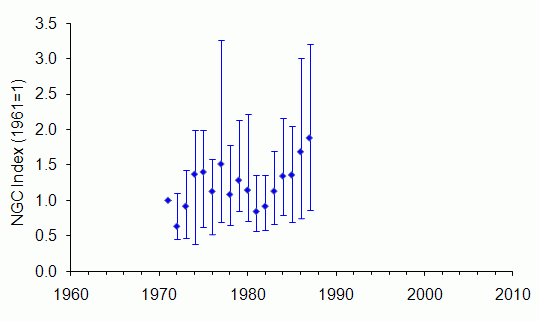
Data were available only for the period 1971-1987, during which there was no significant trend in the bag index. A total of 274 wildcats were recorded by the NGC from 40 shooting estates in central, eastern and north-eastern Scotland in 1984-1985 (Easterbee et al. 1991).
Change in wildcat bags over time, with 95% confidence limits (see statistical methods):
| Country |
Sites |
Start
year |
End
year |
Change (%)
1961-2009 |
Change (%)
1984-2009 |
Change (%)
1995-2009 |
| Scotland |
51 |
1971 |
1987 |
125
-17 to 290 |
no data |
no data |
* significant at P < 0.05
Wales
There are too few bag records of wildcat to produce an index graph. 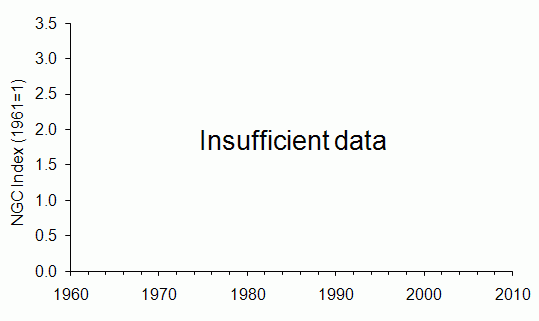
There are too few bag records of wildcat to evaluate rates of change over time
| Country |
Sites |
Start
year |
End
year |
Change (%)
1961-2009 |
Change (%)
1984-2009 |
Change (%)
1995-2009 |
| Wales |
Too few sites |
N Ireland
There are too few bag records of wildcat to produce an index graph. 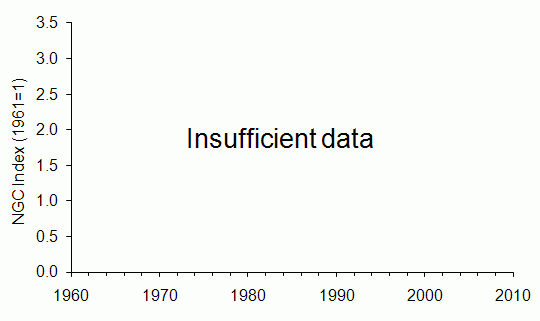
There are too few bag records of wildcat to evaluate rates of change over time
| Country |
Sites |
Start
year |
End
year |
Change (%)
1961-2009 |
Change (%)
1984-2009 |
Change (%)
1995-2009 |
| N Ireland |
Too few sites |
Environmental zones
Change in wildcat bags over time, with 95% confidence limits (see statistical methods):
| Environmental zone |
Sites |
Start
year |
End
year |
Change (%)
1961-2009 |
Change (%)
1984-2009 |
Change (%)
1995-2009 |
| Easterly lowlands (England/Wales) |
Too few sites |
| Westerly lowlands (England/Wales) |
Too few sites |
| Uplands (England/Wales) |
Too few sites |
| Lowlands (Scotland) |
Too few sites |
| Intermediate uplands/islands (Scotland) |
Too few sites |
| True uplands (Scotland) |
Too few sites |
* significant at P < 0.05
Comparison with BBS mammal data
No comparison with the NGC trend is possible because too few wildcat records are received through the Breeding Bird Survey (BBS) organised by the British Trust for Ornithology.
Long-term trend from the National Gamebag Census
There are too few bag records of wildcat to produce a trend starting before 1971.
References and further reading
- Battersby,J. (2005). UK Mammals: Species Status and Population Trends. Joint Nature Conservation Committee/Tracking Mammals Partnership, Peterborough (JNCC download page).
- Easterbee,N., Hepburn,I.V. & Jefferies,D.J. (1991). Survey of the Status and distribution of the Wildcat in Scotland, 1983-1987. Nature Conservancy Council for Scotland, Edinburgh.
- Harris,S., Morris,P., Wray,S. & Yalden,D.W. (1995). A Review of British Mammals: Population Estimates and Conservation Status of British Mammals Other than Cetaceans. Joint Nature Conservation Committee, Peterborough (JNCC download page).
- Harris,S. & Yalden,D.W. (2008). Mammals of the British Isles: Handbook, 4th edition. Mammal Society, Southampton.
- Kitchener,A. (1995). The Wildcat. Mammal Society, Southampton.
- Macdonald,D.W., Daniels,M.J., Driscoll,C., Kitchener,A. & Yamaguchi,N. (2004). The Scottish Wildcat: Analyses for Conservation and an Action Plan. Wildlife Conservation Research Unit, University of Oxford, Oxford.
This report should be cited as: Aebischer,N.J., Davey,P.D. & Kingdon,N.G. (2011). National Gamebag Census: Mammal Trends to 2009. Game & Wildlife Conservation Trust, Fordingbridge (http://www.gwct.org.uk/ngcmammals).
Return to species list